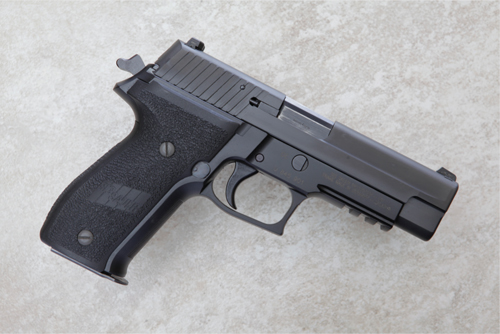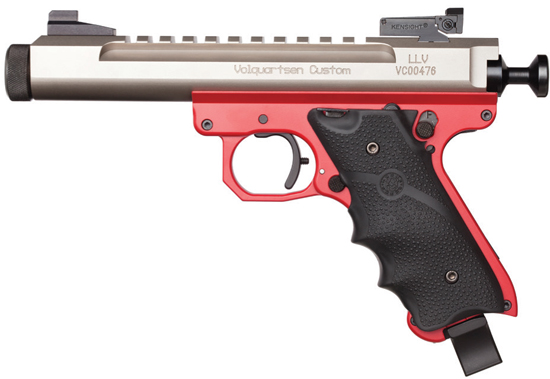

Now that you have an understanding of how pistols work, think back to your answer to the question about why you want to get involved in shooting. The “right” pistol all depends on your situation. If you are looking for a self-defense gun to keep in your house, a full-sized pistol might work best. But perhaps you are a woman who needs a smaller carry pistol for your purse. Other concealed-carry license holders may wish to carry a pistol in an ankle holster. In that case, a revolver, or subcompact semiautomatic, may be more appropriate.
My First Gun

The author’s first gun purchase, a full-size 9mm SIG Sauer P226 pistol.
In 2009, I had been at Google for two years and became financially stable. I had come out of grad school in 2007 with a lot of student debt and wanted to structure my finances so I could have some fun money. For years, I had been thinking about buying a gun but I didn’t have the financial resources until starting at Google.
I went to Bay Area Gun Vault in Mountain View, California, one day during a lunch break to go browse and chat. It was sort of love at first sight with the SIG Sauer 9mm P226. I asked if I could hold the pistol, and the sales guy was happy to oblige. Everything just felt right with the P226’s ergonomics and aesthetics.
Even though I’m now a Glock guy and shoot a Glock 34 in competition, the P226 will always hold a special place in my heart.
What type of gun you get really depends on your goals. When I purchased my Sig, I wasn’t interested in accuracy or the shooting sports. It was really simple—I wanted a cool-looking gun from a reputable company. Just like I’ve always appreciated Apple products for their form factor and aesthetics, I bring the same approach to firearms and other things I invest in. However, I soon realized that I didn’t want my pistol sitting in a safe collecting dust. When Top Shot started airing in 2010, it piqued my interest in learning how to become a better marksman.
While I suggest that beginners start off with a .22 pistol, either a semiautomatic or revolver, I obviously didn’t take my own advice. However, the first gun I ever shot was a Ruger Single Six .22LR revolver, as I mentioned at the beginning of this book.
The reason why I recommend starting with a .22 is because the ammunition is cheap, which means you’ll be able to afford to practice a lot. Secondly, due to the .22’s low recoil, new shooters can ingrain really good habits that will benefit them should they graduate to larger calibers. I often practice with a .22LR pistol to retrain or reinforce good trigger control, sight alignment, and sight picture.
There are a variety of .22 pistols out there. Pictured here is a Ruger Mk III (pronounced “mark three”) pistol, which is a common entry level pistol. What is really fun is that you can optimize this gun several ways—including adding a new trigger, sights, barrel, and other features—when you get to the point of wanting to improve your gear. Styles of pistols also vary radically. For example, a Volquartsen “Scorpion” model .22 pistol has a very different look compared with a stock Ruger Mk III. It’s all part of finding what kind of gun represents your style and meets your particular needs. There’s a range in price from a few hundred to thousands of dollars for the majority of pistols available.

The Ruger Mk III. An affordable, entry-level .22 pistol

The author’s Volquartsen .22LR pistol, built off a Ruger Mk III platform.
Let’s go back to why you want to buy a pistol. If the answer is self-defense, home defense, or both, then I would not recommend a .22 because it lacks the stopping power of a larger round. If you ever need to shoot someone (and hopefully you never do), you want to stop the threat. Larger rounds generally have more stopping power. However, the type of bullet, its weight, and the amount of powder are a few contributing factors. Suggestions vary within the shooting community as to which caliber is best, but a general rule is to use the largest caliber you can accurately control. Many experts agree that .38 or 9mm is the minimum self-defense caliber; however, others might say .32ACP will work just fine.
Other considerations when researching which pistol to purchase is barrel length. Whether on a pistol, shotgun, or rifle, a longer barrel generally translates to the user having an easier time with sight alignment. This is because of a longer sight radius, the distance between the front and rear sights. When researching which pistol barrel length you want to buy, you want to consider that a shorter barrel, and therefore smaller gun, will be easier to conceal if you wish to carry a firearm (check your local and state laws on concealed-carry permits). But with that shorter barrel, you will trade a little bit of accuracy and possibly speed acquiring your target.
A 5-inch barrel .45ACP pistol will often be easier to handle than a 3-inch .45ACP subcompact pistol (Generally speaking, 3 inches is subcompact, 4 inches is compact, and 5 inches or larger is full size). If you go with a .22LR pistol, barrel length will be fairly inconsequential when it comes to recoil management. Also of note is that smaller pistols generally hold fewer rounds than larger ones, depending on the magazine size used.
Once you’re done researching some of the details, nothing really replaces going out and handling the firearms you’re interested in. Head to your local gun shop or range to check out their selection. The following are some things to look for:
Finally, nothing replaces test firing. Computer games or video games don’t even come close to the real thing. You should not spend your hard-earned money on a pistol unless you’ve fired that particular model, or at least fired a pistol that is very similar to the one you want to buy. Many gun ranges offer multiple pistol models to rent, and some ranges will even apply your range fees as a discount toward the purchase of a gun if you buy it on the same visit.
Once you’ve decided on what make and model pistol to buy, prices can vary from shop to shop. Buying a firearm online is also an option. The dealer will ship your firearm to your local federal firearms licensee (FFL) dealer. You’ll then go to the FFL to complete your paperwork, background check, and other requirements. One online retailer I can recommend for both great prices and customer service is Bud’s Gun Shop (www.BudsGunShop.com). I purchased multiple firearms from Bud’s that I then used to train with for Top Shot. Not only were the prices the lowest I could find, I really enjoyed working with their customer service.
There are online auction sites where you can also bid on firearms. Many gun owners also post to many gun forums, where there are no shortage of pictures and descriptions. Just like buying anything else online, be prudent about whom you buy things from. A common arrangement is for the seller to allow a buyer to cancel an order upon inspecting the firearm at the FFL. If the seller won’t allow this arrangement, buy with care, or continue searching.
Accessories
As a beginner, I recommend sticking with the bare minimum at first and slowly building your gear as you see fit. Gear expenses can add up quickly, and many shooters (including myself) have purchased gear in haste, thinking we needed or wanted it, and now have a collection of stuff we never use.
Here’s a short list of pistol accessories you might consider:
Chapter Summary: